Ultimate Guide to Local SEO
SEO Guide For Businesses in Jacksonville, FL Looking to Increase Traffic to their Website and Gain NEW Customers
Search Engine Optimization (SEO) is a series of tactics designed to increase the visibility of your website – and traffic to it! – from search engines like Google, Bing, and Yahoo!.
Bottom line: SEO works, especially for small-to-midsize businesses seeking local traffic, i.e. from Jacksonville, FL consumers.
We’ll explore how SEO works in much more detail in this guide, but let’s start with one key statistic:
Per Google, 50% of mobile phone users are likely to visit a physical, local store on the same day that they perform a Google search.
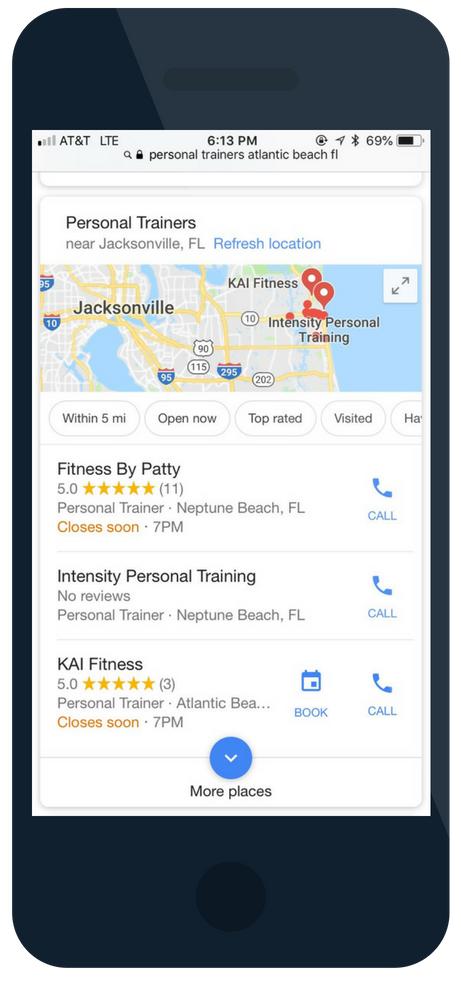
So, the question is…
Will your business be the one that customers see and therefore call or visit?
The SEO Guide for All Businesses & Companies Serving Jacksonville, FL
This SEO guide is relevant for any of the below business and companies that serve a local area:
- Attorneys – family law, criminal defense, personal injury, business law, etc.
- Doctors & Medical Practices – general practitioners, specialists, clinics, hospitals, chiro, dentists, acupuncturists, etc.
- Health & Beauty – salons, makeup artists, personal trainers, massage therapists, etc
- Automotive & Car Dealerships – new and used dealerships, mechanics, auto bodywork, tires, oil changes
- Home Services – contractors, plumbers, lawn care, roofers, electricians, etc.
- Schools – preschools, specialty schools, colleges, and universities
- Hospitality – hotels, restaurants, tour companies, local attractions
- Financial – CPAs, financial planners, wealth managers, stockbrokers
- Insurance – home, auto, medical, hurricane, flood,
- Retail – any retail business with a physical location
- Professional Services – couriers, temp agencies, printing services, security companies
Also, this information applies to franchise businesses.
The goal of SEO is to get your business to rank for a keyword phrase such as “the service or product you offer + your city.”
Here are some examples:
- pain specialists Jacksonville, FL
- engagement rings Jacksonville, FL
- Montessori schools Ponte Vedra Beach, FL
- flood insurance St Augustine, FL
In this guide, we’ll dive into the series of tactics needed to rank for relevant keyword phrases for your business and give you actionable tips you can put into practice today to help your business rank better for local Jacksonville searches.
What is Local SEO?
Search Engine Optimization means that your website shows up in the results when a potential customer uses a search engine to find a business like yours. Here’s the tricky part, though – Google changes its algorithm 500 to 600 times every year! So needless to say, a lot has changed with Google over the years.
Below is a breakdown of the modern SERP (search engine results page) and the various sections that make it up.
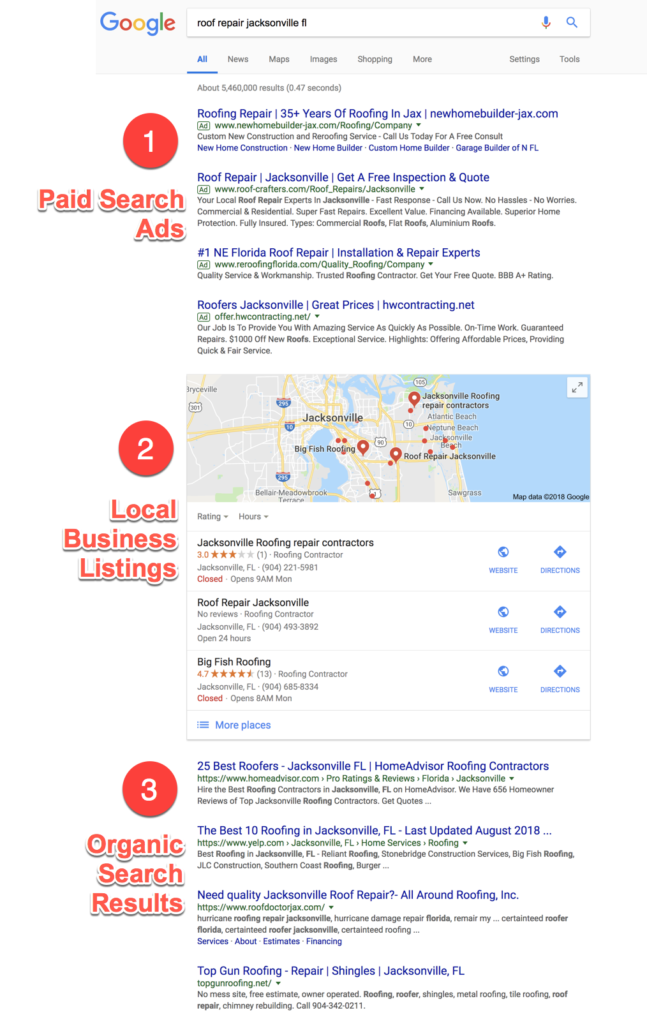
Google Ads. At the very top of every search results page, you’ll see the paid search ads for the search term. We cover paid search (also called Pay Per Click advertising, or PPC) in another guide. For now, just note that paid search definitely has its place in online marketing, but you should not rely on it as a substitute for SEO because 70% – 80% of users ignore paid advertisements.
Local business listings. Powered by Google My Business profiles and website optimization, this “Local 3 Pack” lists a selection of local businesses with relevant details.
Organic search results. Organic listings are still relevant to SEO, but their ability to generate a lot of traffic is dwindling as Google increasingly emphasizes the Local 3 Pack.
For businesses in Jacksonville and those that serve the local North Florida market, your focus should be on Local SEO and showing up in the local business listings, or the “Local 3 Pack.” The goal is to optimize your website for keywords that contain a local geographical qualifier, such as, “AC repair Jacksonville, FL” or “financial managers Ponte Vedra Beach”.
Ranking for location-specific keyword phrases relevant to your industry will have many long-term benefits for your business and continually bring in strong ROI from your SEO efforts. Additionally, you should supplement your SEO efforts with a targeted pay-per-click campaign in both Google and Bing, as well as an ongoing social media strategy focused on creating local brand awareness and trust through the sharing of useful, relevant information.
The combination of all three of these initiatives, anchored by strong SEO, will keep your business top-of-mind with local consumers.
Benefits of a Strong SEO Program

Leads originating from search engines have an incredible 14.6% close rate!
On average, search engines drive 300% more traffic to websites than social media channels do. That means you need to show up in search results relevant to your business. Furthermore, 75% of search engine users never click past the first page of search results. That means you need to show up as close to the top search results as possible – ideally, inside the Local 3 Pack.
And when you do – when your SEO program succeeds – it yields bountiful benefits.
Better search rankings pay off. If you can hit the first position on Google search results – which is especially possible if you’re competing on local search terms rather than national – SEO potential customer leads have a 14.6% average close rate, according to Search Engine Journal. By contrast, outbound leads, like print ads, have only a 1.7% close rate.
Benefits of a strong SEO program:
- Boosts brand exposure & credibility
- Increases website traffic
- Improves the quality of traffic to your website
- Enjoys a high conversion rate
- Drives offline sales
- Gives smaller businesses a level playing field versus big companies and competitors
- Helps businesses to break into new markets and access new customers
- Generates strong overall ROI for SEO initiative
Local Search Ranking Factors
Most people think SEO focuses mostly on keywords. Use the right words in the right places on the right pages and you’re set, right?
Not exactly. The formula behind Google’s algorithm is quite sophisticated and looks at numerous elements, many of which are subtle and/or technical. SEO software and toolmaker, Moz, studied the ranking factors that affect local search listings to understand what factors play a role and how much of a role they play.
They found the following eight search ranking factors:
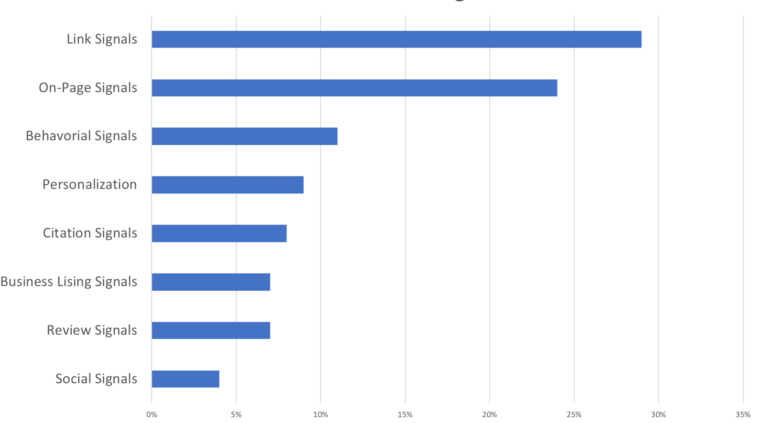
The Ranking Factors Explained
- Links – Inbound anchor text, linking domain authority, the number of links
- On-Page Optimization – Presence of NAP, keywords in copy and page tags, domain authority
- Behavioral Signals – Click thru rate, mobile clicks to call, check-ins, etc.
- Personalization – Ways in which the web experience is customized for visitors
- Citations – NAP consistency across data aggregator sites, citation volume
- Business Listing – Geographical proximity to the searcher, categories, keyword in business title
- Online Reviews – Review quantity, review velocity, review diversity
- Social Mentions – Engagement on Facebook, Instagram, Twitter, YouTube, etc.
Let’s dive deeper into each ranking factor and discuss how these specifically affect Jacksonville, FL businesses, as well as give best practices for each.
The SEO Formula for Jacksonville Businesses & Companies
So, how do you address all the ranking signals described above?
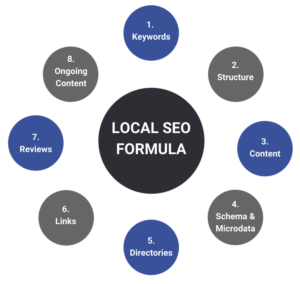
Follow the 8-pronged SEO formula for Jacksonville businesses:
- Do Keyword Research & Select Keywords
- Establish Website Structure
- Create Website Content
- Address Schema.org and Microdata
- Get Added to Business Directories
- Build Links
- Cultivate Reviews
- Proceed with On-Going Content Development
#1 – Keyword Research
First, you must pick the right keywords to go after. This is the single most important SEO initiative.
Keyword research allows us to identify the words and phrases that searchers are actually using when they research your product or service.
Utilize Google’s Keyword Planner to help determine the best keywords to target on each page of your website and blog. It’ll give you a ton of additional information about what exactly consumers are searching in your local market and how they’re narrowing down their search and shopping process.
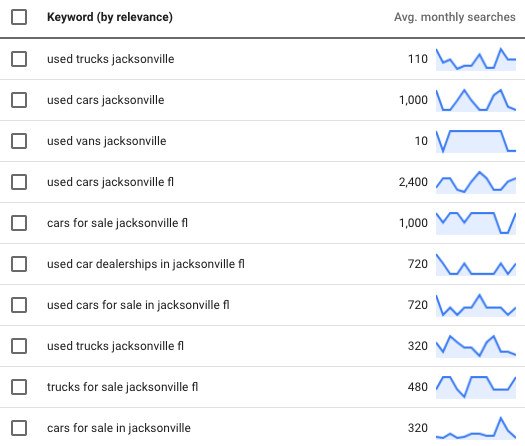
Keywords phrase and their avg. monthly search volume from Google’s Keyword Research Tool
For most of you, the keywords you need and want to target are going to contain a local geographical or neighborhood qualifier.
For example, you don’t just want to target:
“used trucks”
Non-location specific keywords mean you’ll be competing against all types of national dealers that sell preowned vehicles and happen to have a local franchise.
Instead, you want to target:
“used trucks Jacksonville, FL”
First, this is the location where you actually serve your customers. Second, a localized search term will face much less competition, so you can rank more quickly and easily.
Keyword Research Action Item:
Once you have your keywords, choose only two keywords to target for each service or product page on your website. Make sure those keywords are used a few times throughout the page you are optimizing.
#2 – Site Structure
Make sure your website is properly structured.
Specifically, you want to ensure that consumers can easily navigate through your site and find the pages most relevant to them.
A good site structure has a clear and easy-to-use main menu organizing the various sections of your website, along with submenu items that allow quick access to more specific/detailed pages within each main section.
For example, if you are a dentist that also offers teeth whitening, then you want a page about cleanings/checkups, as well as a page about the teeth whitening service you offer. The same goes for any other specific services, i.e. fillings, crowns, dentures, etc.
You also want to include pages focused on your local area. In general, the pages you’ll need on your website are:
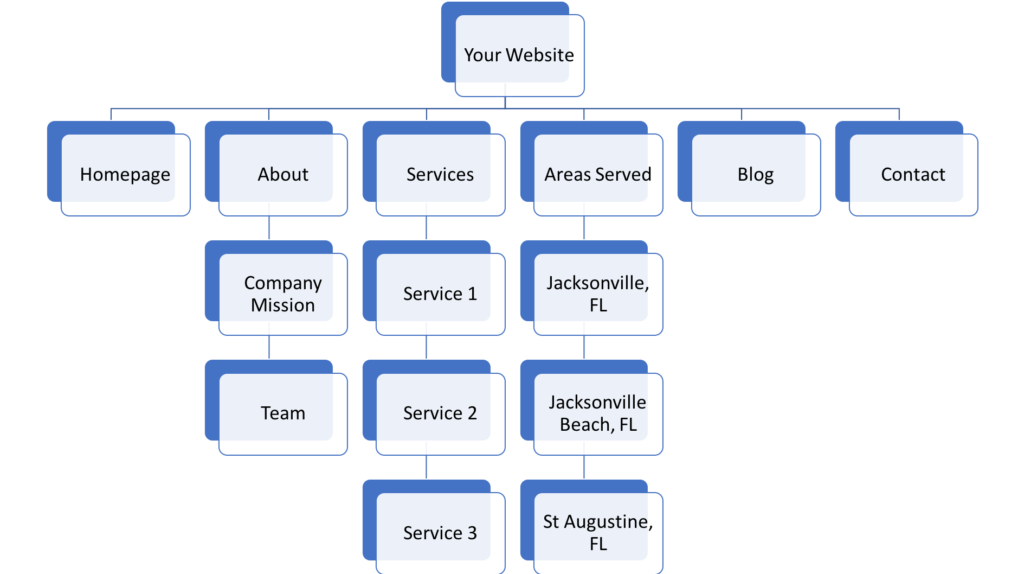
Example of sitemap for a local business website
You might also have additional one-off pages, depending on your situation. For example, you might include a Promotional or Coupon page if it’s applicable to your business.
The top-level pages are the same ones that will show up in the main navigation menu at the top of the website. The sub-pages usually only appear in the menu if the user hovers the cursor over the top-level page.
This is very much a core sitemap that any business website can use. It’s a great starting point for your website.
Site Structure Action Item:
From here, customize this basic site map to include one page for each individual service you offer and each Jacksonville/North Florida neighborhood that you service. If you are a store with a physical location, then only include the one location page focused on where you’re store is located.
#3 – Content

Content in many forms: written copy/articles, video, images, audio, and infographics
Content is king.
In the world of digital marketing and SEO, content is king. Without it, the web would not exist. More to the point, content is critical to SEO. Andrey Lipattseve, Partner Development Manager and former Search Quality Senior Strategist at Google, says that high-quality content and link building (which we’ll discuss momentarily) are the top two signals used by Google to rank it in search results.
But what is content, exactly?
Content comes in various forms. Website pages, articles, videos, and images are the most common forms of content and important elements for both SEO and marketing.
The key to content: it must be meaty.
The days of thin, fluffy copy are OVER! Copy needs to be direct, descriptive, detailed, and well-organized around each service that you offer and each location that you serve.
For example, if you are a restaurant in Jacksonville that additionally offers a catering service, then you need to create a dedicated Catering page that describes the catering menu in detail and describes the service in detail, including information on your wait staff, delivery, party planning, etc. Don’t be afraid to go into detail – Google frequently favors long pages. For reference, the average first-page result on Google is 1,890 words long.
Content Action Item:
Have at least one dedicated page for each service or product that you offer. That page should be at least 750+ words in length and give a full-scope view of what you’re offering, the benefits of your product/service, all the features available, and a strong call to action. Use no more than two keywords per page and use those keywords several times throughout the page.
Doing this will ensure your website and service pages will rank when local consumers search for the products or services you offer.
#4 – Schema.org Structured Data and Microdata
Every web page contains more information than is presented to readers. The behind-the-scenes code – or markup language – contains a ton of information that is aimed at search engines like Google specifically.
This behind-the-scenes information is sometimes called microdata, structured data, or schema markup. It’s information about the content on the web page, and it tells search engines how to understand, categorize, and present the content from the web page. Simply put, it helps search engines to better understand what each page is about.
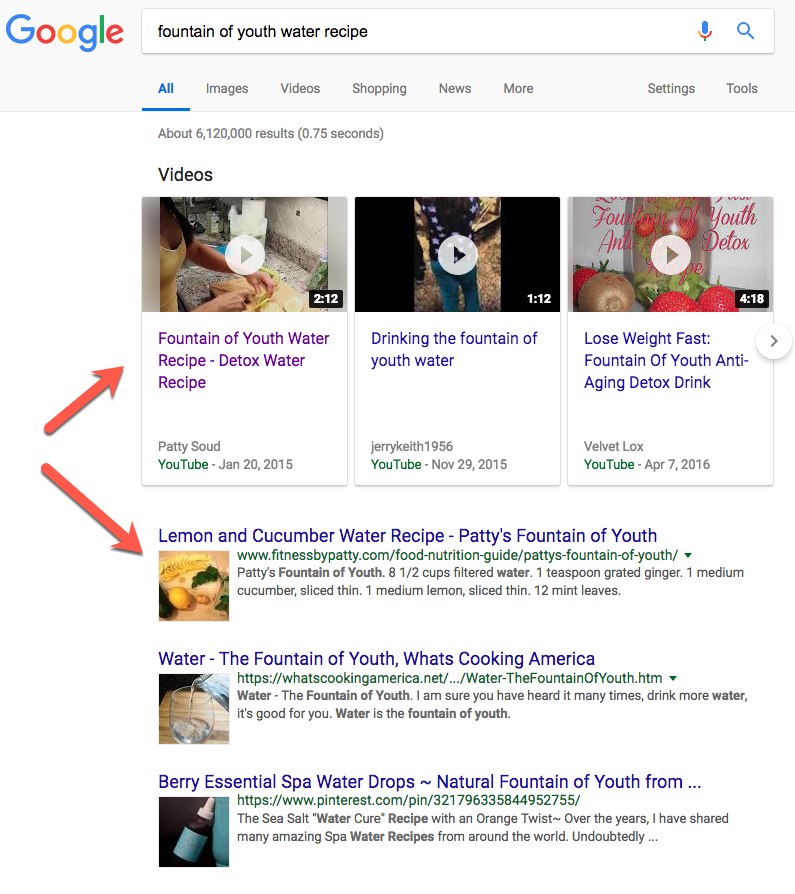
Schema markup gives Fitness By Patty’s search listing extra visibility for both video and regular listings
**The schema markup on FitnessByPatty.com cucumber lemon water detox page helps give it extra visibility on search results and thus sending a lot more traffic to both the YouTube video and website page. This particular video has been viewed over 100,000x and helps her gain sales of her cookbook and nutrition guide.
In terms of local SEO specifically, you can use schema markup that makes it clear to Google and other search engines that you’re a local business, not a big brand. This can help you rank higher among local businesses. More importantly, providing structured data to the search engines makes your site a better search result and allows Google to extract what’s called “rich snippets.”
There are various microdata formats depending on the type of business and type of content on the page. Some of the Schema.org microdata format choices include:
- Business
- Person
- Review
- Event
- Video
- Article
- Recipe
Schema.org Action Item:
For more information, visit Schema.org, which is a collaboration between Google, Microsoft, Yahoo!, and others. It serves as a central repository of schema information. It can guide users through the process of incorporating the appropriate microdata into their website. And fortunately, it’s a relatively straightforward process that doesn’t require a lot of strategy. It’s mostly about doing it and knowing its benefits.
I suggest having Schema Markup at least for your core business information: name, business category, address + map link, phone, hours of operation, etc.
**This information needs to be available on your website page, as well as the schema markup code.
You can also check your website’s microdata output at https://search.google.com/structured-data/testing-tool.
#5 – Online Business Directories & Data Aggregators
Whether you manage a single location or multi-location franchise, the consistency of your NAP (name, address, phone number) information across the Web will either help grow your business or serve as a barrier to customer discovery.
Listing accuracy creates trust with Google and Bing. So, search engine algorithms scour the Web looking for information about your business to make sure that it all matches. It will look for data elements like:
- Business name
- Address
- Phone Number
- Hours of operation
- Products or services offered
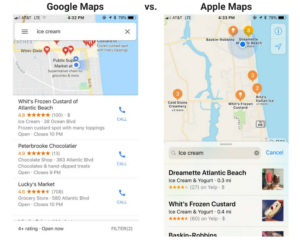
Big difference between map and local info providers
Google looks at these types of websites to help determine the accuracy of your business information:
- Phone directories
- Industry-specific business directories like OpenTable, Healthgrades, or FindLaw
- Review sites like TripAdvisor and CitySearch
- Local news websites (First Coast News, Channel 4, Jacksonville Business Journal, etc.)
- Local government websites (JaxChamber.com)
The top business directories and data aggregators for Local SEO:
- Google My Business
- Bing Places for Business
- Apple Maps
- Superpages
- Infogroup
- Localeze
- Factual
- CitySearch
- Insider Pages
- Best of the Web
- Hot Frog
- Acxiom
- YP – Yellow Pages
- Yelp
- Foursquare
If Google and other search engines look at those sites, you need to be doing so too. If nothing else, you want to ensure any information they have listed about you is accurate. But they can also potentially serve as sources of links to your site (the ranking signal which we’ll discuss next) and as entryways for new customers to discover your business.
Business Directories Action Item:
Make sure you have a Google My Business listing set up and properly and accurately filled out. Then, search for variations and inaccuracies in your data across top directory sites. As you find them, fix them.
#6 – Build Links
Links are the number one local organic-ranking factor.
Websites with the highest numbers of quality inbound links will always rank better and receive more traffic than those with relatively few links by comparison.
Why? Both Google and Bing view a link as a vote.
If another website links to your website through an article or page, search engines view that link as an indicator that your website has something good to offer to the audience. Consequently, they will rank your website higher than other websites with similar content but fewer links.
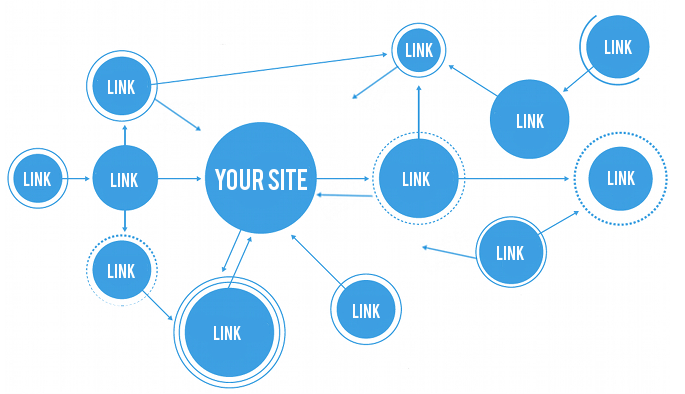
Links matter. A website with links from other good, credible websites will rank well for many years to come
Also, links from high authority websites are more powerful than links from smaller, less authoritative websites. For example, a link from an article on The Jacksonville Business Journal is more powerful than a link from a local blog.
A lot of companies offering SEO in Jacksonville view building links as poor practice, both “spammy” and unnecessary. Link-building is actually critical to SEO, and it’s spammy only if you’re unscrupulous and follow link-building tactics that Google prohibits. By not performing this task, most SEO companies hold their clients back from top results.
The good news is you have plenty of clean options for building good quality links. Utilizing the link building tactics below will cause no harm and will indisputably benefit your site, as all the sources listed are good quality, high authority websites and associations.
Link Building Action Item:
Here are the very best, safest, and most powerful options for building local links in Jacksonville, FL:
- Guest post on local news, business sites, and blogs
- First Coast News
- Jacksonville Business Journal
- Jacksonville.com
- OldCity.com
- Become a guest on a podcast
- Join the local Chamber of Commerce
- Jax Chamber
- St. Johns County Chamber of Commerce
- Join local affiliations and networks
- Jacksonville Bar Association
- Jacksonville Marketing Association
- Northeast Florida Builders Association
- etc.
- Get involved in the community
- Local charities
- Local church groups
- Sponsor school sports
- Sponsor little league teams
- etc.
- Create high-quality content that local business owners find useful enough to link to on their websites and that consumers find useful enough to share on social media. This is critical. We’ll revisit it in Step #8.
#7 – Reviews
Online reviews are an important part of how your website ranks in search engine results. They contribute nearly 10% of the weight of the final ranking. Moreover, they’re even more important when it comes to showing up in the Local 3 Pack (section #2 in our breakdown of a SERP – see an excerpt below).
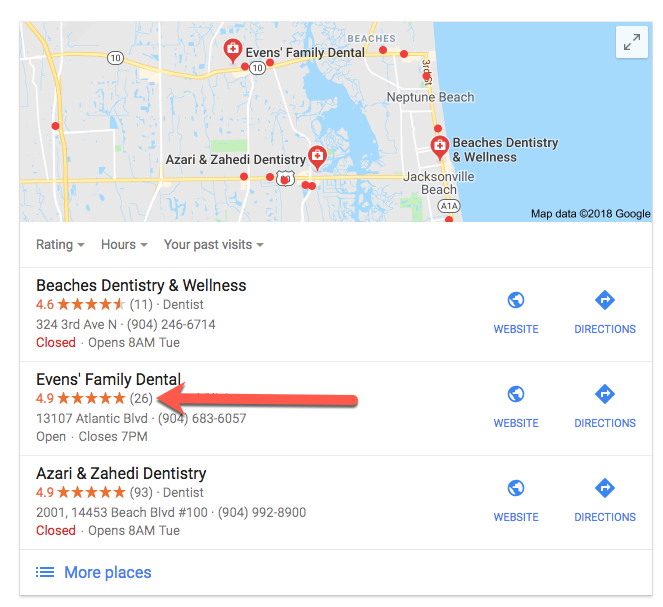
In the Local Pack, reviews account for 13% of the weight of the final ranking!
Further, reviews do more than just get you to show up in search results. They have an enormous impact on sales and conversions.
Search engines consider several factors when looking at reviews, including:
- Review quantity
- Review quality
- Review star ratings
- Review diversity
- Reviews across multiple review sites
- Review consistency and freshness
In short, search engines are looking for businesses that consistently get a good number of strong reviews with positive comments coming from the top review sites. Those businesses stand a far better chance of getting ranked and receiving traffic from local search results.
Reviews Action Item:
If you need help gaining reviews, I recommend using a review management tool like Birdeye or Podium. Both cost around $250 per month, but they will absolutely skyrocket the number of reviews you receive each month. They work by either emailing or texting your customer after being serviced. The message contains links to post a review on a few sites of your choosing: Google, Facebook, Angie’s List, Citysearch, etc.
#8 – Ongoing Content Development

Ongoing content development has the ability to take your brand and business to the next level – huge traffic and increased market share.
Keeping your marketing fresh and current is key to today’s digital, ever-evolving world.
Websites are like people – they must grow in strength over time, establishing a solid content core and then strengthening that core with awesome supporting content, including articles, videos, images, and infographics.
Start with core pages.
As described above in Step #3, if you’re just starting out, focus on your core service pages first. These pages are the backbone of your SEO efforts and provide critical detailed information about your company and all your services for prospective customers to make a buying decision.
Add a blog or resources section.
From here, start to add a blog or some type of resources section that provides educational content related to your product or service. You can blog about anything that gives a good window into your knowledge and expertise. Consumers need to know, like, and trust you before they will decide to buy from you, and a blog offers numerous benefits:
- It builds a relationship over time, so consumers can come to know and like you.
- It helps your audience with their needs, ensuring the relationship is positive and fruitful.
- It credentials your expertise, so consumers can trust you to solve their problems and, even better, view you as a thought-leader in your local area.
- It establishes a positive first impression online, as it’s often through a search or social media that consumers first come to your blog posts.
- It enhances audience reach by giving you something to share on social media sites like Facebook, Instagram, and LinkedIn.
- It gives you the opportunity to address a wider variety of keywords and key phrases, so your website can capture a far greater range of searches. Each blog post offers a new, distinct doorway into your site from search engines.
Favor topics of local interest, if possible, but don’t shy away from topics with universal appeal.
For example, you might write about the different neighborhoods or regions that you service, or you might contribute to issues or conversations that are happening locally. If you provide yard services, you might write about local ordinances or regulations and their enforcement.
That said, you can – and should – still write about topics with universal appeal. If you’re an HVAC company in Jacksonville, for instance, you can blog about:
- Tips for improving the energy efficiency of your AC system
- Tips for improving the longevity of your AC system
- What to do with your AC system when you’re remodeling or adding on to your home
- Company news
- Company events
- Etc.
Note how the first three bullet points on that list aren’t specifically about your product or service. Your readers care more about themselves than they do about you. Sorry, but it’s true. Write about things that will help and benefit them.
Content Development Action Item:
Create a content development strategy and plan. This doesn’t have to be complicated. You basically need a list of new blog posts and pages to be added to your website each month.
Start out by adding 1 – 2 new pages or blog posts, and then scale up if time allows.
Ultimately, you should aim to publish as much content as is practical. HubSpot has found that “companies that published 16+ blog posts per month got almost 3.5X more traffic than companies that published between 0 – 4 monthly posts.”
The more new content you can create and publish on your website, the stronger your rankings will become over time, and the more traffic you will generate to your website from search engines.
That said, a daily or near-daily publishing schedule is often not logistically possible for many businesses, particularly if you want all the content to be high-quality.
Quality should outrank quantity. Don’t waste your time on poorly conceived content just to meet some imaginary publishing quota. The main consequence of a slower publishing schedule is just that it will take a little longer to reap the traffic rewards, but even just 1 – 2 posts a month will still ultimately pay off with increased search engine visibility and traffic.
You can also revisit old posts in the absence of publishing tons of new content. Updating and republishing old blog posts can increase traffic by more than 100%. HubSpot refers to this tactic as “Historical Optimization,” or going back to old posts to update them. They increased the number of monthly organic search views of old posts by 106% by doing so.
Conclusion
SEO is not optional in today’s world. Failure to address SEO considerations will simply see your site lost to the void of distant search results no one ever sees.
Ultimately, your site’s presence and performance on the web is part of a much larger whole, and your approach to leveraging the mechanics of web searches must be strategic and multi-pronged. Always remember that all the steps and tips discussed in this article are just a means to an end. Your site, how it’s structured, and all its content are always part of a flow – a flow that you want to control (or at least influence).
And you can! By optimizing your site to work with search engines, you can capture more traffic, generate more leads, and land more business. SEO is how you do it.
